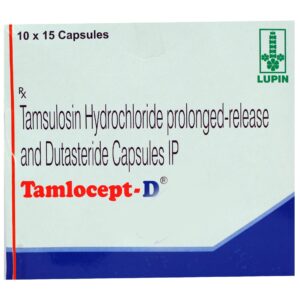DUTASETERIDE + TAMSULOSIN
Dutaseteride: Dutasteride is a medication primarily used to treat enlarged prostate, also known as benign prostatic hyperplasia (BPH). It is sold under the brand name Avodart.
Mechanism of Action:
Dutasteride belongs to a class of medications known as 5-alpha-reductase inhibitors. It works by inhibiting the enzyme 5-alpha-reductase, which converts testosterone to dihydrotestosterone (DHT). By reducing DHT levels, dutasteride helps shrink the prostate gland and improve urinary symptoms associated with BPH.
Use:
Dutasteride is prescribed for the treatment of symptomatic BPH in men with an enlarged prostate. It can help relieve symptoms such as difficulty urinating, weak urine flow, frequent urination, and the need to urinate urgently.
Dose:
The recommended dose of dutasteride for BPH is 0.5 mg once daily. It is important to follow the prescribed dosage and take the medication as directed by a healthcare professional.
Side Effects:
Like any medication, dutasteride can cause side effects. Common side effects may include decreased libido (sex drive), erectile dysfunction, ejaculation disorders, breast enlargement or tenderness, and dizziness. These side effects are usually mild and temporary, but if they persist or worsen, it is advisable to consult a healthcare provider.
Serious side effects are rare but can occur. These include allergic reactions such as rash, itching, swelling of the face, lips, or throat, and difficulty breathing. If any severe side effects are experienced, immediate medical attention should be sought.
It is important to note that dutasteride may increase the risk of developing high-grade prostate cancer. Patients should inform their doctor of any family history of prostate cancer and seek regular prostate cancer screening while taking this medication.
As always, before starting any new medication, it is recommended to consult a healthcare professional to understand the risks, benefits, and suitability of dutasteride for individual circumstances.
Tamsulosin: Tamsulosin is a medication commonly prescribed under the brand name Flomax. It belongs to a class of drugs known as alpha-1 blockers, which are primarily used to treat symptoms associated with an enlarged prostate, a condition called benign prostatic hyperplasia (BPH).
The primary action of tamsulosin is to relax the smooth muscles in the prostate gland and bladder neck. By doing so, it helps to relieve urinary symptoms such as difficulty in urination, weak urine flow, frequent urination, and the urgent need to urinate. Tamsulosin specifically targets the alpha-1 receptors found in the prostate, resulting in improved urine flow and reduced BPH symptoms.
The recommended dose of tamsulosin is typically 0.4 mg per day, taken orally as a single dose. It is usually administered 30 minutes after a meal at the same time each day to maintain steady levels in the body. However, the specific dosage and administration instructions may vary depending on individual circumstances, so it is important to follow the advice of a healthcare professional.
As with any medication, tamsulosin can cause certain side effects. Common side effects include dizziness, headache, drowsiness, abnormal ejaculation (e.g., decreased semen volume), nasal congestion, and runny nose. These side effects are usually mild and temporary. However, in rare cases, tamsulosin may cause more serious side effects such as orthostatic hypotension (a sudden drop in blood pressure upon standing) leading to dizziness or fainting, retrograde ejaculation (semen going into the bladder instead of out of the penis), and priapism (a prolonged and painful erection).
It is essential to discuss potential drug interactions and any existing medical conditions with a healthcare professional before starting tamsulosin. This medication should not be taken in combination with certain other drugs, especially those that lower blood pressure, as it may increase the risk of severe hypotension. Additionally, tamsulosin may not be suitable for individuals with specific medical conditions such as liver or kidney problems, certain eye conditions (e.g., cataracts or glaucoma), or a history of low blood pressure.
Overall, tamsulosin is a well-tolerated and effective medication for managing the symptoms of BPH, but it is important to carefully follow dosage instructions and consult with a healthcare professional to ensure its safe use.

